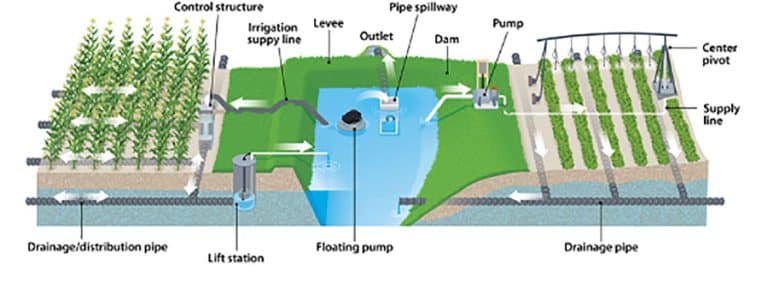Maximize Efficiency. Don’t Undersize Your Future.
Choosing the correct tile size is critical to the performance of your system. Proper planning ensures that water moves efficiently, without overloading any part of the network.
We utilize state-of-the-art equipment and can plow up to 24″ dual-wall pipe, and are capable of installing larger mains as necessary. Our goal is to exceed your expectations with drainage systems built to perform.
At East River Land Improvement, whenever we can, we design and install your system to be Drainage Water Management (DWM) compatible… and we do it at no additional cost. What that means is with the addition of both above ground control structures and farmable inline structures, you now have control of moisture received. It’s one of the ways we focus on long-term results, not just quick fixes, so your land can stay productive for the next generation.
What is the Difference Between Conventional Drainage and Drainage Water Management?
Conventional drainage—often called tile drainage—is a way to passively remove extra water from farmland using a system of corrugated plastic pipes. These pipes help keep the soil in optimal condition for growing crops by preventing flooding, improving airflow in the soil, and allowing farmers to plant and harvest in a timely fashion. These systems typically rely on a daylight or lift station outlet to allow excess moisture to freely exit the soil profile. As an open system, there’s no control or regulation of water flow—it simply removes excess moisture as conditions allow.
- Prevents Waterlogging: Too much water can damage plant roots and stop crops from growing. Tile remove the excess moisture.
- Improves Soil Airflow: Good drainage lets air reach plant roots, helping them grow strong and healthy.
- Extends the Growing Season: With less water in the way, farmers can get into their fields sooner in spring and harvest earlier in fall.
- Laterals: Small pipes that collect water from the field.
- Main Drain: A larger pipe that carries all that collected water away.
- Outlets: The final exit point, where the water flows into a ditch, stream, or another waterway.
- Healthier Soil: Drier, well-aerated soil helps crops thrive and improves nutrient use.Less Erosion: Controlled water flow reduces the risk of soil washing away.
- More Sustainable Farming: Proper drainage protects the land and keeps it productive for future generations.
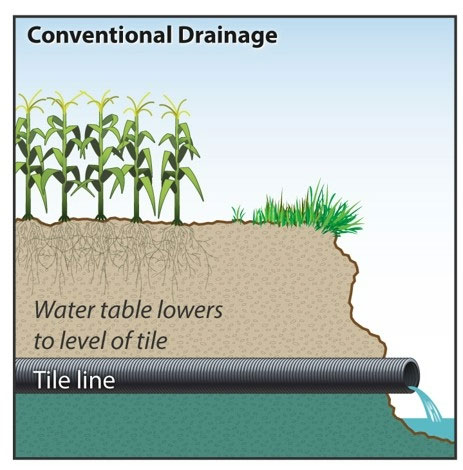
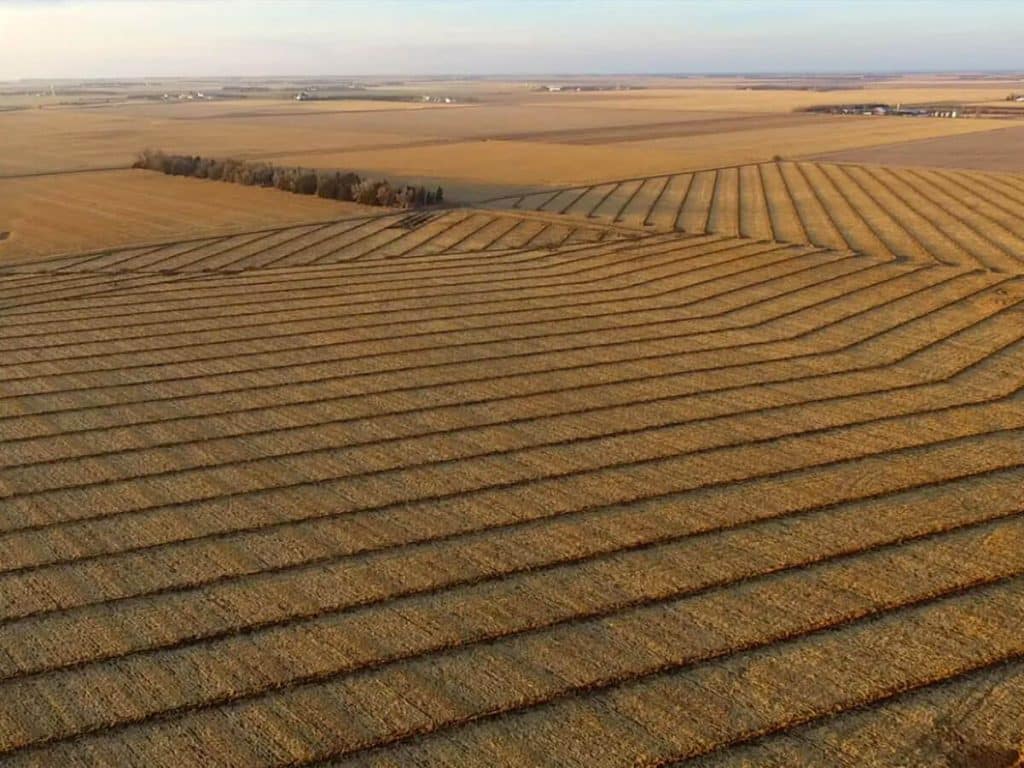
What is Controlled Drainage (Drainage Water Management)?
Controlled drainage is a smarter way to manage water in farm fields. It uses simple devices—like adjustable gates or stop logs—at the end of tile drainage systems or ditches to help farmers control how much water stays in the soil and how much drains away.
The Drainage Water Management (DWM) method is more effective than traditional drainage. The DWM practice uses simple water control structures in the drainage system to manage the water table during the growing season increasing available water for the crops. This practice recognizes that open drainage systems are not beneficial at all times throughout the year. Designing and installing this type of system takes education, experience, an enhanced level of care, and attention to detail, so retrofitting to a conventional drainage system is simply not cost effective. The ongoing management of control structures can be manual or automated.
Precision Water Control for Higher Yields
Farmers can raise or lower these control structures to hold more water in the field or let more out. This gives them the ability to adjust water levels depending on the weather, the season, and their crops’ needs.
- Holds More Water When Needed: Helps keep water in the soil during dry periods, which can boost crop yields.
- Reduces Runoff and Pollution: Slows down drainage to reduce the loss of nutrients like nitrogen and phosphorus into nearby streams and lakes.
- Less Need for Irrigation: With more water stored in the soil, crops may need less extra watering.
- Better for the Environment: Controlled drainage supports sustainable farming by saving water and protecting water quality.
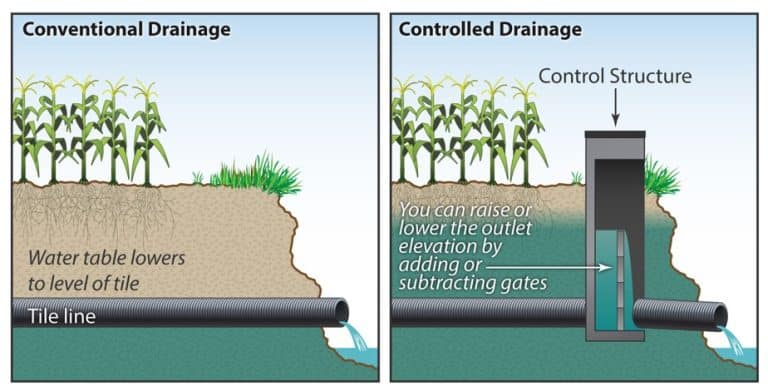
In short, controlled drainage gives farmers the ability to truly manage their water instead of relying on a system that constantly drains. This flexibility allows for better crop performance and fewer negative impacts on the environment.
Lift Stations
Lift stations (also called pump stations) are used on farms to move drainage water from low spots to higher ground when water can’t drain naturally due to flat terrain. These systems are essential for farms where gravity drainage doesn’t work, helping keep fields dry from oversaturation.
What is a Lift Station in Agriculture?
Lift stations use pumps to move water collected from tile drainage systems or surface drains up to an outlet like a ditch, stream, or waterway. This helps farmers drain water from fields that would otherwise stay too wet.
- Better Drainage in Flat Fields: Makes drainage possible where gravity alone isn’t enough.
- Higher Yields: Keeps roots from getting waterlogged so plants can grow better and absorb more nutrients.
- Faster Field Access: Helps dry fields faster in the spring and fall, so planting and harvesting aren’t delayed.
- Water Reuse: Allows drainage water to be collected and reused for irrigation.
- Less Crop Damage: Helps prevent erosion, nutrient loss, and flooding.
- More Design Flexibility: Lets farmers install drainage systems in more efficient ways.
- Remote Control: Many modern systems can be monitored and controlled remotely, saving time and effort.
- Pump: Usually a submersible pump that lifts the water, often with a screen to block debris.
- Wet Well: A holding area where water collects before being pumped.
- Discharge Pipe: Carries the water away from the field.
- Control Panel: Monitors water levels and turns the pump on and off.
- Power Source: Typically electric, but solar options are available for remote areas.
- Proper Design: A good lift station requires careful planning based on the land’s slope, soil, and drainage needs.
Lift stations help farmers manage water on fields that would otherwise be too wet due to lack of gravity or daylight outlet, improving crop performance, reducing delays, and supporting smarter water use.
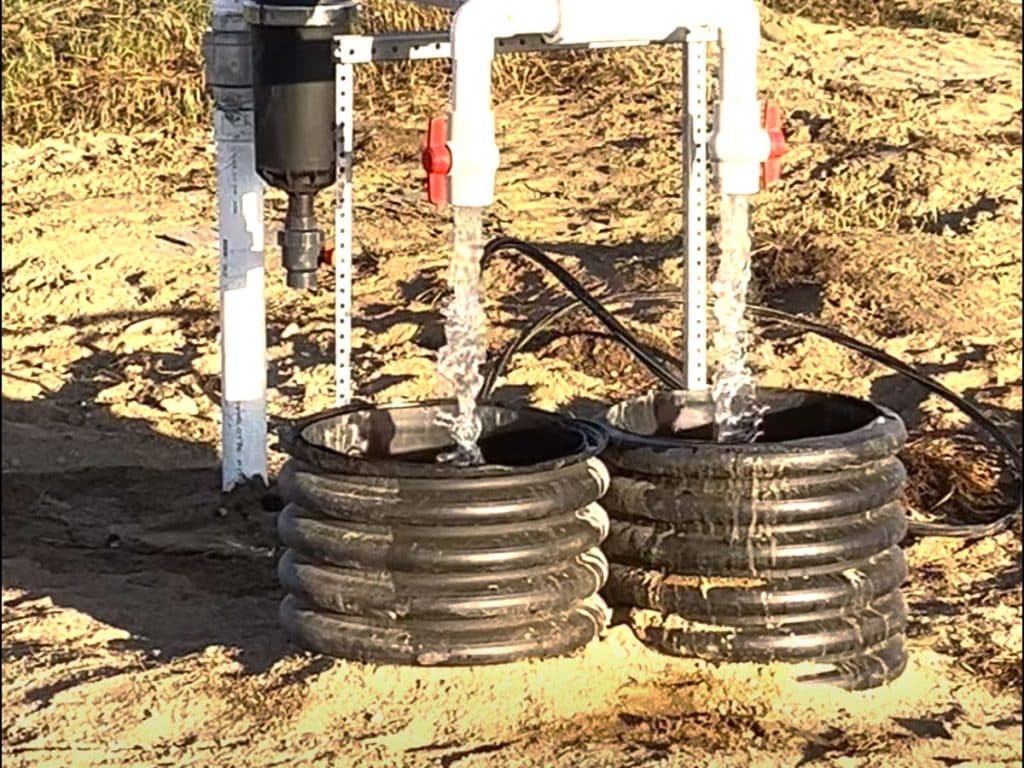
SubSurface Irrigation (SSI)
Subsurface Irrigation allows water to be introduced into a DWM system from a well or retention pond—effectively turning your drainage system into an irrigation source.
Subsurface Irrigation allows water to be introduced into a DWM system from a well or retention pond—effectively turning your drainage system into an irrigation source. uses underground pipes to either drain excess water from the soil or deliver water directly to plant roots. It helps maintain the right water level in the field, which improves crop health and yields.
Dual-Function Systems for Irrigation + Drainage
Engineered for flexibility, SSI is the next evolution in land productivity and sustainability.
- Lower water requirements
- No surface evaporation
- Uniform moisture delivery
- Enhanced root zone control
- Drainage Mode:
Buried perforated pipes (called tile lines) collect extra water from the soil and move it away from the root zone. This prevents flooding and helps roots get the air they need. - Irrigation Mode:
In certain systems, the same underground pipes can be used to deliver water back into the field. Water is pumped into the tile lines and controlled with special structures that raise or lower the water table to feed plant roots. - System Parts Include:
- A water source (like a pond or reservoir)
- A pump to move water
- Control structures to manage water levels
- Buried tile lines that carry water in or out
- Better Water Control:
Keeps soil moisture levels just right—not too wet, not too dry. - Higher Yields:
Consistent water supply helps crops grow stronger and healthier. - Fewer Weeds and Diseases:
Less water on the surface means fewer weeds and reduced risk of disease spread. - Supports Irrigation: In dry areas or sandy soils, subirrigation can help supplement natural rainfall.
- Proper Design is Key: A system made for drainage might not work for subirrigation without changes.
- Water Source Needed: For irrigation, you’ll need a steady and reliable source of water.
- Regular Maintenance: To keep the system running well, routine upkeep is necessary.
Subsurface irrigation is a smart way to manage water below the surface—helping crops thrive by keeping moisture levels in check and protecting the soil from both too much and too little water.
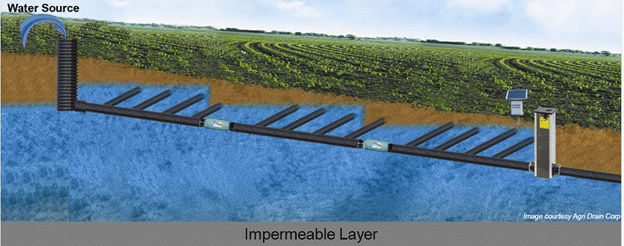
We’re Not Just Improving Land—We’re Investing in Your Legacy.
Whether you need a standard drainage system or a fully integrated DWM + SSI solution, we’re here to help you make the most of your land for years to come.
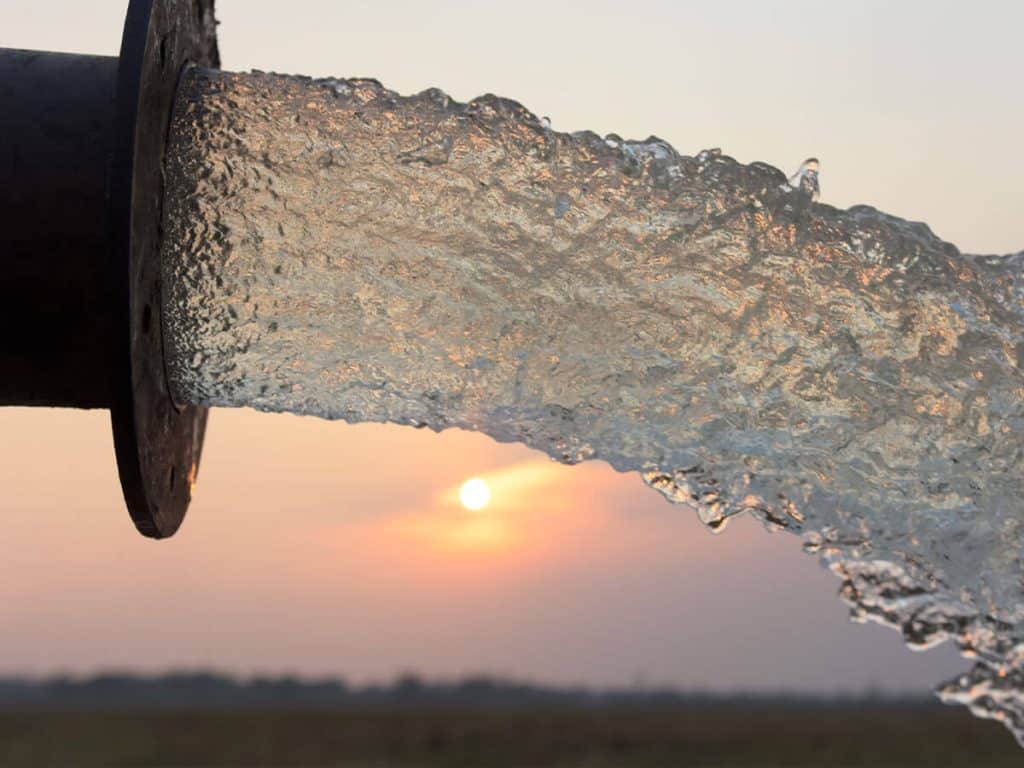
Drainage Water Recycling
Drainage Water Recycling is a way for farmers to collect and reuse water that drains off their fields. This includes water from underground drainage pipes and sometimes surface runoff. Instead of letting that water go to downstream, it’s stored and reused to irrigate crops during dry times—helping boost yields, conserve water, and reduce pollution.
- Collecting Water: Water is gathered from tile drainage systems (perforated pipes underground) and sometimes from surface runoff.
- Storing Water: The collected water is stored in a reservoir, such as a pond or holding area on the farm.
- Reusing Water: When rainfall isn’t enough, the stored water is pumped out and used to irrigate crops—helping them stay healthy and productive.
- Higher Yields: Crops have a more reliable water source during dry spells, which can increase production.
- Less Nutrient Runoff: Capturing and reusing water helps keep nutrients like nitrogen and phosphorus from washing into rivers and lakes.
- Water Savings: By reusing water already on the farm, DWR reduces the need for outside water sources.
- Irrigation Options: The recycled water can be used with many irrigation systems, including drip, sprinkler, and center pivot systems.
- Lower Costs Over Time: Reusing water from your own land can save money on irrigation in the long run.
- Water Management: It takes planning to manage how much water goes into and out of the system, especially when the weather is unpredictable.
- Sizing the Reservoir: You need to make sure the storage pond is the right size to meet your irrigation needs.
